Business Analysis Report on Data, MIS, and Flexible Working
VerifiedAdded on 2022/10/03
|23
|7035
|104
Report
AI Summary
This report provides a comprehensive business analysis, examining various aspects of data collection, management information systems (MIS), and flexible working arrangements within an organizational context. The report begins by exploring population and sampling techniques, including the application of stratified sampling and the theoretical frameworks underpinning flexible working hours, such as boundary theory, resource theory, and work/family border theory. It then delves into the crucial differences, advantages, and disadvantages of primary and secondary data collection methods. The report further analyzes the importance of an effective MIS, using British Petroleum (BP) as a case study, outlining the concepts, components, and design steps of an MIS. The analysis includes the pyramidal structure, physical and functional components, and characteristics of an MIS at BP, along with its purpose in management and operation. The report concludes by synthesizing the findings and offering insights into how these elements contribute to organizational productivity and effectiveness.

Due Date:
BUSINESS ANALYSIS
Name of the Student:
Name of the University:
Module Code:
Referencing Style: Harvard
BUSINESS ANALYSIS
Name of the Student:
Name of the University:
Module Code:
Referencing Style: Harvard
Paraphrase This Document
Need a fresh take? Get an instant paraphrase of this document with our AI Paraphraser
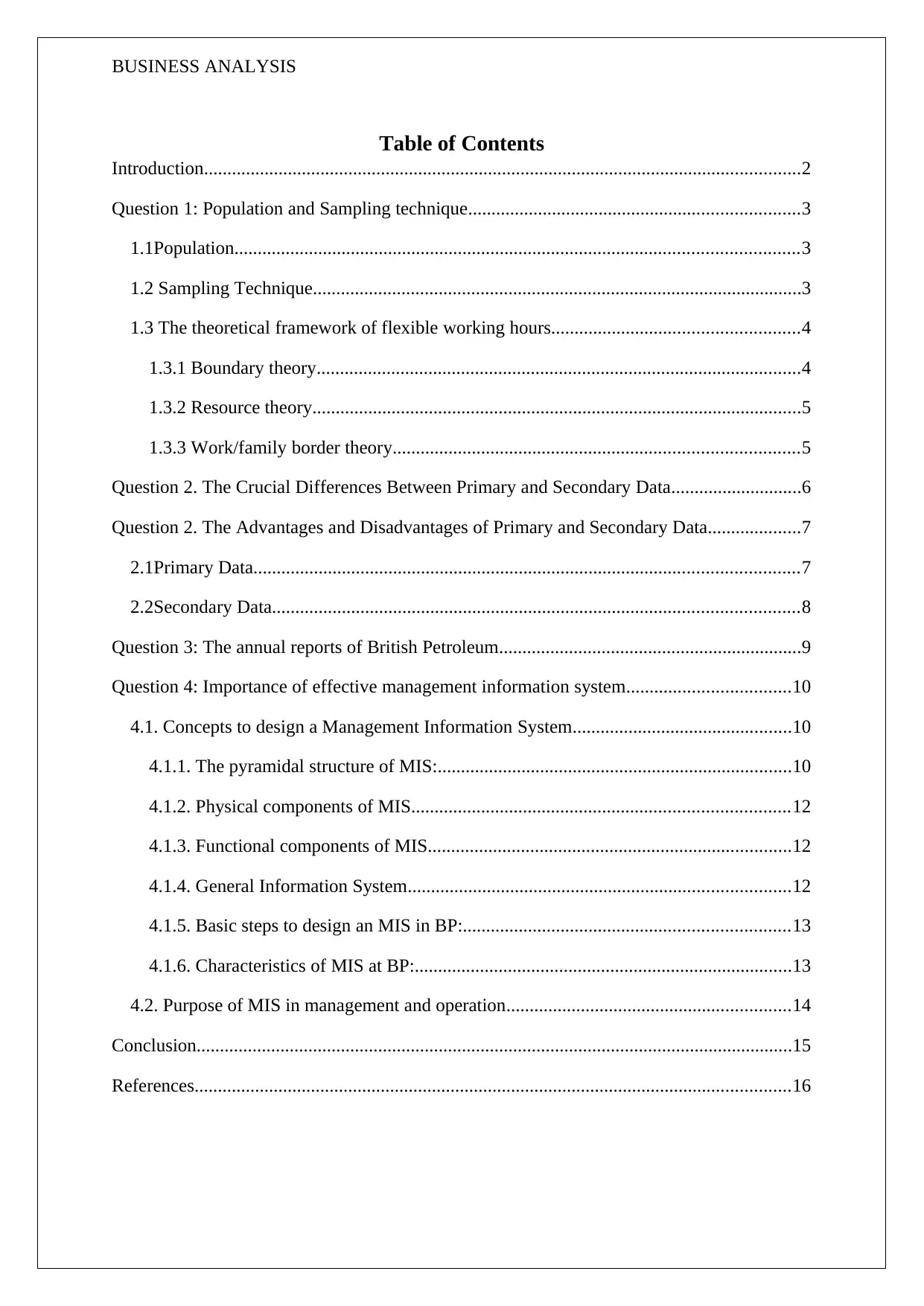
BUSINESS ANALYSIS
Table of Contents
Introduction................................................................................................................................2
Question 1: Population and Sampling technique.......................................................................3
1.1Population.........................................................................................................................3
1.2 Sampling Technique.........................................................................................................3
1.3 The theoretical framework of flexible working hours.....................................................4
1.3.1 Boundary theory........................................................................................................4
1.3.2 Resource theory.........................................................................................................5
1.3.3 Work/family border theory.......................................................................................5
Question 2. The Crucial Differences Between Primary and Secondary Data............................6
Question 2. The Advantages and Disadvantages of Primary and Secondary Data....................7
2.1Primary Data.....................................................................................................................7
2.2Secondary Data.................................................................................................................8
Question 3: The annual reports of British Petroleum.................................................................9
Question 4: Importance of effective management information system...................................10
4.1. Concepts to design a Management Information System...............................................10
4.1.1. The pyramidal structure of MIS:............................................................................10
4.1.2. Physical components of MIS.................................................................................12
4.1.3. Functional components of MIS..............................................................................12
4.1.4. General Information System..................................................................................12
4.1.5. Basic steps to design an MIS in BP:......................................................................13
4.1.6. Characteristics of MIS at BP:.................................................................................13
4.2. Purpose of MIS in management and operation.............................................................14
Conclusion................................................................................................................................15
References................................................................................................................................16
Table of Contents
Introduction................................................................................................................................2
Question 1: Population and Sampling technique.......................................................................3
1.1Population.........................................................................................................................3
1.2 Sampling Technique.........................................................................................................3
1.3 The theoretical framework of flexible working hours.....................................................4
1.3.1 Boundary theory........................................................................................................4
1.3.2 Resource theory.........................................................................................................5
1.3.3 Work/family border theory.......................................................................................5
Question 2. The Crucial Differences Between Primary and Secondary Data............................6
Question 2. The Advantages and Disadvantages of Primary and Secondary Data....................7
2.1Primary Data.....................................................................................................................7
2.2Secondary Data.................................................................................................................8
Question 3: The annual reports of British Petroleum.................................................................9
Question 4: Importance of effective management information system...................................10
4.1. Concepts to design a Management Information System...............................................10
4.1.1. The pyramidal structure of MIS:............................................................................10
4.1.2. Physical components of MIS.................................................................................12
4.1.3. Functional components of MIS..............................................................................12
4.1.4. General Information System..................................................................................12
4.1.5. Basic steps to design an MIS in BP:......................................................................13
4.1.6. Characteristics of MIS at BP:.................................................................................13
4.2. Purpose of MIS in management and operation.............................................................14
Conclusion................................................................................................................................15
References................................................................................................................................16
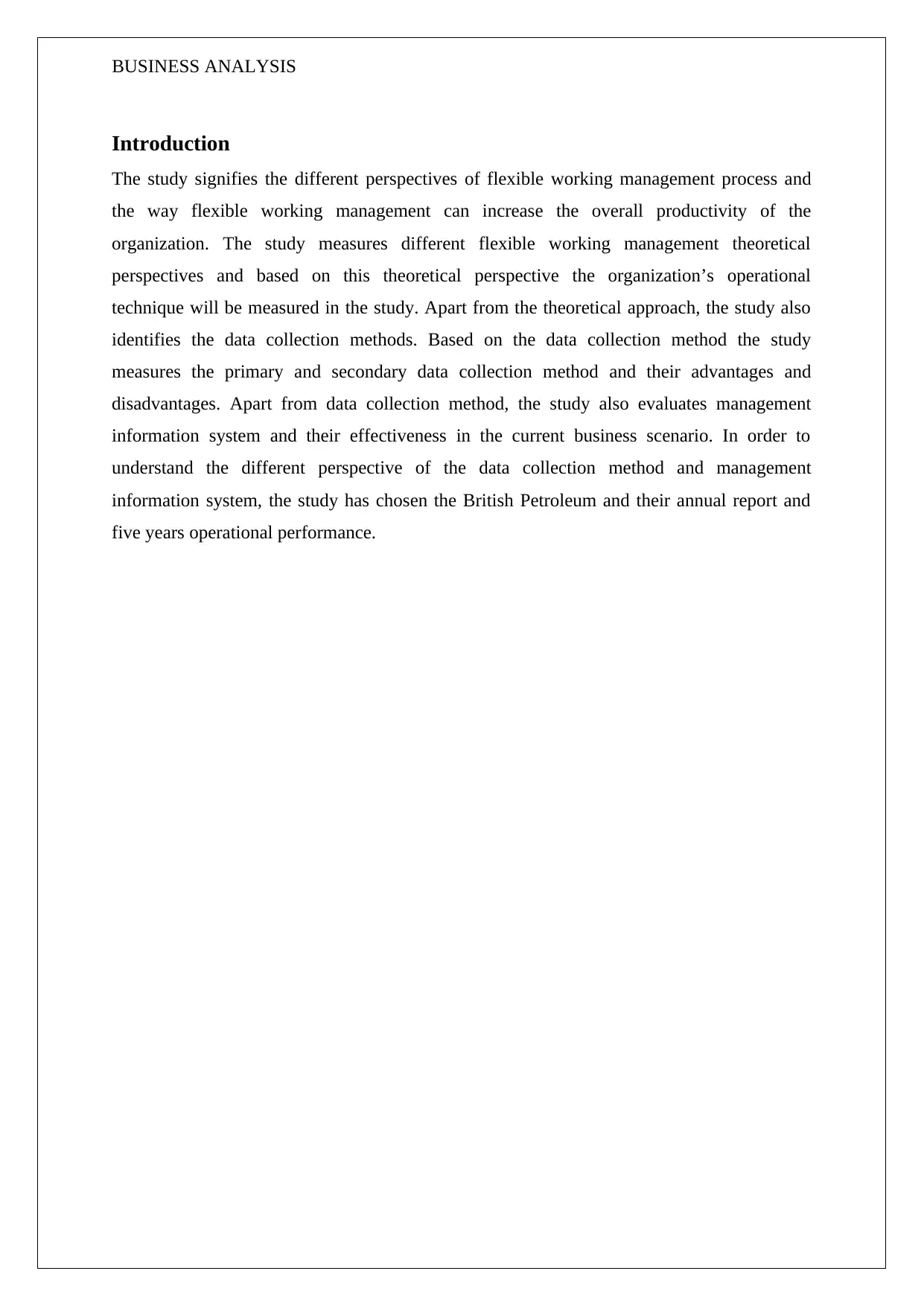
BUSINESS ANALYSIS
Introduction
The study signifies the different perspectives of flexible working management process and
the way flexible working management can increase the overall productivity of the
organization. The study measures different flexible working management theoretical
perspectives and based on this theoretical perspective the organization’s operational
technique will be measured in the study. Apart from the theoretical approach, the study also
identifies the data collection methods. Based on the data collection method the study
measures the primary and secondary data collection method and their advantages and
disadvantages. Apart from data collection method, the study also evaluates management
information system and their effectiveness in the current business scenario. In order to
understand the different perspective of the data collection method and management
information system, the study has chosen the British Petroleum and their annual report and
five years operational performance.
Introduction
The study signifies the different perspectives of flexible working management process and
the way flexible working management can increase the overall productivity of the
organization. The study measures different flexible working management theoretical
perspectives and based on this theoretical perspective the organization’s operational
technique will be measured in the study. Apart from the theoretical approach, the study also
identifies the data collection methods. Based on the data collection method the study
measures the primary and secondary data collection method and their advantages and
disadvantages. Apart from data collection method, the study also evaluates management
information system and their effectiveness in the current business scenario. In order to
understand the different perspective of the data collection method and management
information system, the study has chosen the British Petroleum and their annual report and
five years operational performance.
⊘ This is a preview!⊘
Do you want full access?
Subscribe today to unlock all pages.

Trusted by 1+ million students worldwide
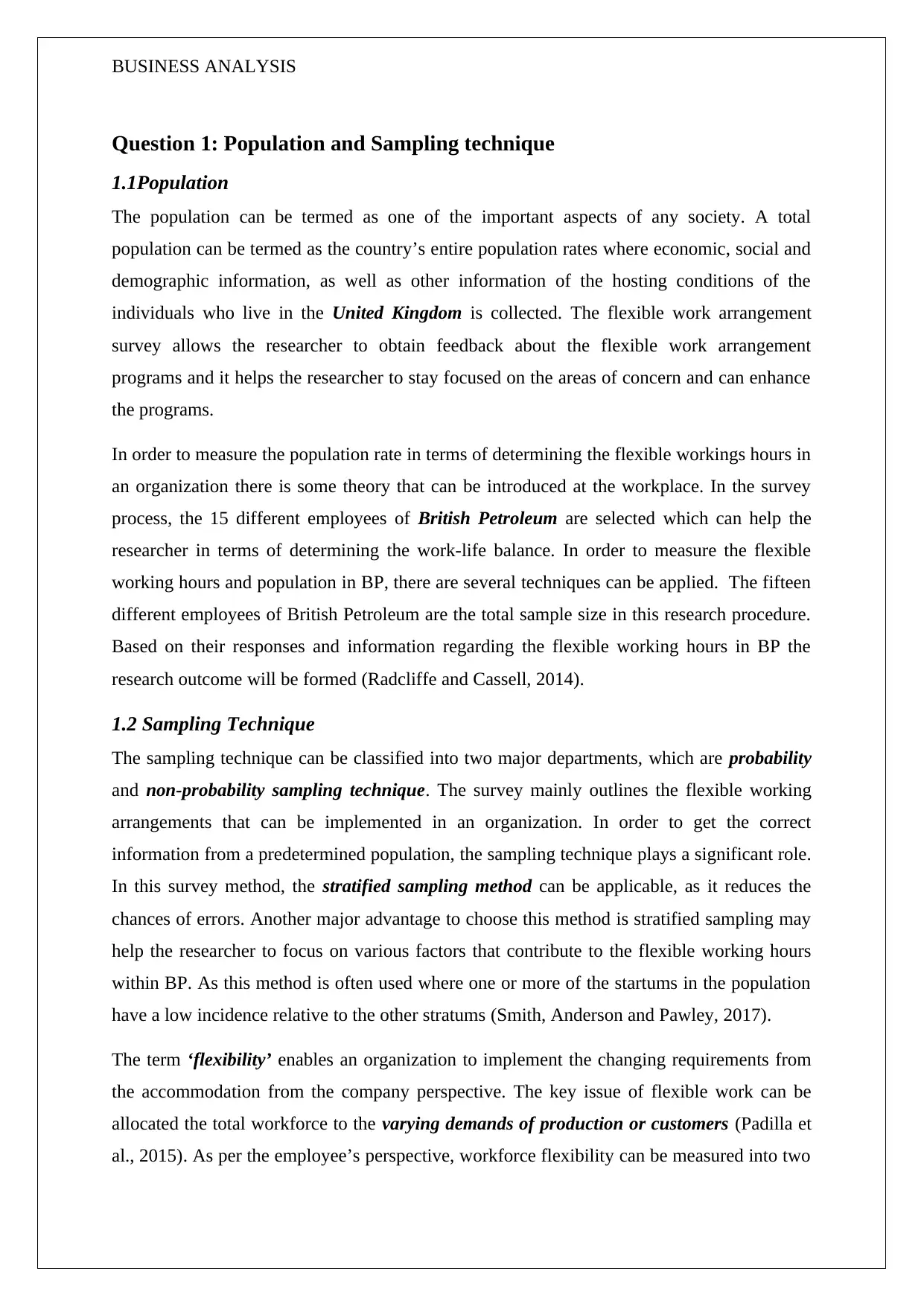
BUSINESS ANALYSIS
Question 1: Population and Sampling technique
1.1Population
The population can be termed as one of the important aspects of any society. A total
population can be termed as the country’s entire population rates where economic, social and
demographic information, as well as other information of the hosting conditions of the
individuals who live in the United Kingdom is collected. The flexible work arrangement
survey allows the researcher to obtain feedback about the flexible work arrangement
programs and it helps the researcher to stay focused on the areas of concern and can enhance
the programs.
In order to measure the population rate in terms of determining the flexible workings hours in
an organization there is some theory that can be introduced at the workplace. In the survey
process, the 15 different employees of British Petroleum are selected which can help the
researcher in terms of determining the work-life balance. In order to measure the flexible
working hours and population in BP, there are several techniques can be applied. The fifteen
different employees of British Petroleum are the total sample size in this research procedure.
Based on their responses and information regarding the flexible working hours in BP the
research outcome will be formed (Radcliffe and Cassell, 2014).
1.2 Sampling Technique
The sampling technique can be classified into two major departments, which are probability
and non-probability sampling technique. The survey mainly outlines the flexible working
arrangements that can be implemented in an organization. In order to get the correct
information from a predetermined population, the sampling technique plays a significant role.
In this survey method, the stratified sampling method can be applicable, as it reduces the
chances of errors. Another major advantage to choose this method is stratified sampling may
help the researcher to focus on various factors that contribute to the flexible working hours
within BP. As this method is often used where one or more of the startums in the population
have a low incidence relative to the other stratums (Smith, Anderson and Pawley, 2017).
The term ‘flexibility’ enables an organization to implement the changing requirements from
the accommodation from the company perspective. The key issue of flexible work can be
allocated the total workforce to the varying demands of production or customers (Padilla et
al., 2015). As per the employee’s perspective, workforce flexibility can be measured into two
Question 1: Population and Sampling technique
1.1Population
The population can be termed as one of the important aspects of any society. A total
population can be termed as the country’s entire population rates where economic, social and
demographic information, as well as other information of the hosting conditions of the
individuals who live in the United Kingdom is collected. The flexible work arrangement
survey allows the researcher to obtain feedback about the flexible work arrangement
programs and it helps the researcher to stay focused on the areas of concern and can enhance
the programs.
In order to measure the population rate in terms of determining the flexible workings hours in
an organization there is some theory that can be introduced at the workplace. In the survey
process, the 15 different employees of British Petroleum are selected which can help the
researcher in terms of determining the work-life balance. In order to measure the flexible
working hours and population in BP, there are several techniques can be applied. The fifteen
different employees of British Petroleum are the total sample size in this research procedure.
Based on their responses and information regarding the flexible working hours in BP the
research outcome will be formed (Radcliffe and Cassell, 2014).
1.2 Sampling Technique
The sampling technique can be classified into two major departments, which are probability
and non-probability sampling technique. The survey mainly outlines the flexible working
arrangements that can be implemented in an organization. In order to get the correct
information from a predetermined population, the sampling technique plays a significant role.
In this survey method, the stratified sampling method can be applicable, as it reduces the
chances of errors. Another major advantage to choose this method is stratified sampling may
help the researcher to focus on various factors that contribute to the flexible working hours
within BP. As this method is often used where one or more of the startums in the population
have a low incidence relative to the other stratums (Smith, Anderson and Pawley, 2017).
The term ‘flexibility’ enables an organization to implement the changing requirements from
the accommodation from the company perspective. The key issue of flexible work can be
allocated the total workforce to the varying demands of production or customers (Padilla et
al., 2015). As per the employee’s perspective, workforce flexibility can be measured into two
Paraphrase This Document
Need a fresh take? Get an instant paraphrase of this document with our AI Paraphraser
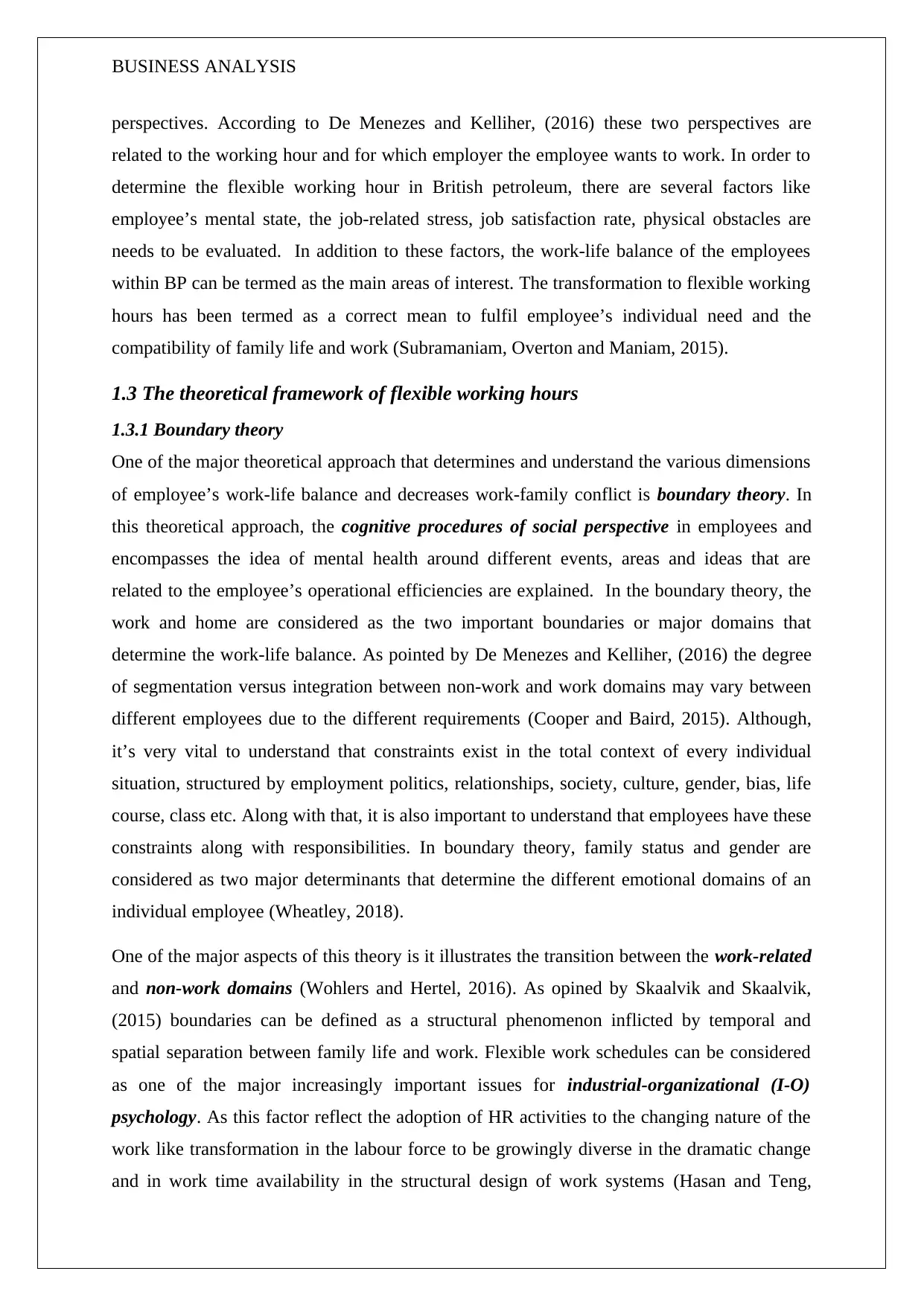
BUSINESS ANALYSIS
perspectives. According to De Menezes and Kelliher, (2016) these two perspectives are
related to the working hour and for which employer the employee wants to work. In order to
determine the flexible working hour in British petroleum, there are several factors like
employee’s mental state, the job-related stress, job satisfaction rate, physical obstacles are
needs to be evaluated. In addition to these factors, the work-life balance of the employees
within BP can be termed as the main areas of interest. The transformation to flexible working
hours has been termed as a correct mean to fulfil employee’s individual need and the
compatibility of family life and work (Subramaniam, Overton and Maniam, 2015).
1.3 The theoretical framework of flexible working hours
1.3.1 Boundary theory
One of the major theoretical approach that determines and understand the various dimensions
of employee’s work-life balance and decreases work-family conflict is boundary theory. In
this theoretical approach, the cognitive procedures of social perspective in employees and
encompasses the idea of mental health around different events, areas and ideas that are
related to the employee’s operational efficiencies are explained. In the boundary theory, the
work and home are considered as the two important boundaries or major domains that
determine the work-life balance. As pointed by De Menezes and Kelliher, (2016) the degree
of segmentation versus integration between non-work and work domains may vary between
different employees due to the different requirements (Cooper and Baird, 2015). Although,
it’s very vital to understand that constraints exist in the total context of every individual
situation, structured by employment politics, relationships, society, culture, gender, bias, life
course, class etc. Along with that, it is also important to understand that employees have these
constraints along with responsibilities. In boundary theory, family status and gender are
considered as two major determinants that determine the different emotional domains of an
individual employee (Wheatley, 2018).
One of the major aspects of this theory is it illustrates the transition between the work-related
and non-work domains (Wohlers and Hertel, 2016). As opined by Skaalvik and Skaalvik,
(2015) boundaries can be defined as a structural phenomenon inflicted by temporal and
spatial separation between family life and work. Flexible work schedules can be considered
as one of the major increasingly important issues for industrial-organizational (I-O)
psychology. As this factor reflect the adoption of HR activities to the changing nature of the
work like transformation in the labour force to be growingly diverse in the dramatic change
and in work time availability in the structural design of work systems (Hasan and Teng,
perspectives. According to De Menezes and Kelliher, (2016) these two perspectives are
related to the working hour and for which employer the employee wants to work. In order to
determine the flexible working hour in British petroleum, there are several factors like
employee’s mental state, the job-related stress, job satisfaction rate, physical obstacles are
needs to be evaluated. In addition to these factors, the work-life balance of the employees
within BP can be termed as the main areas of interest. The transformation to flexible working
hours has been termed as a correct mean to fulfil employee’s individual need and the
compatibility of family life and work (Subramaniam, Overton and Maniam, 2015).
1.3 The theoretical framework of flexible working hours
1.3.1 Boundary theory
One of the major theoretical approach that determines and understand the various dimensions
of employee’s work-life balance and decreases work-family conflict is boundary theory. In
this theoretical approach, the cognitive procedures of social perspective in employees and
encompasses the idea of mental health around different events, areas and ideas that are
related to the employee’s operational efficiencies are explained. In the boundary theory, the
work and home are considered as the two important boundaries or major domains that
determine the work-life balance. As pointed by De Menezes and Kelliher, (2016) the degree
of segmentation versus integration between non-work and work domains may vary between
different employees due to the different requirements (Cooper and Baird, 2015). Although,
it’s very vital to understand that constraints exist in the total context of every individual
situation, structured by employment politics, relationships, society, culture, gender, bias, life
course, class etc. Along with that, it is also important to understand that employees have these
constraints along with responsibilities. In boundary theory, family status and gender are
considered as two major determinants that determine the different emotional domains of an
individual employee (Wheatley, 2018).
One of the major aspects of this theory is it illustrates the transition between the work-related
and non-work domains (Wohlers and Hertel, 2016). As opined by Skaalvik and Skaalvik,
(2015) boundaries can be defined as a structural phenomenon inflicted by temporal and
spatial separation between family life and work. Flexible work schedules can be considered
as one of the major increasingly important issues for industrial-organizational (I-O)
psychology. As this factor reflect the adoption of HR activities to the changing nature of the
work like transformation in the labour force to be growingly diverse in the dramatic change
and in work time availability in the structural design of work systems (Hasan and Teng,
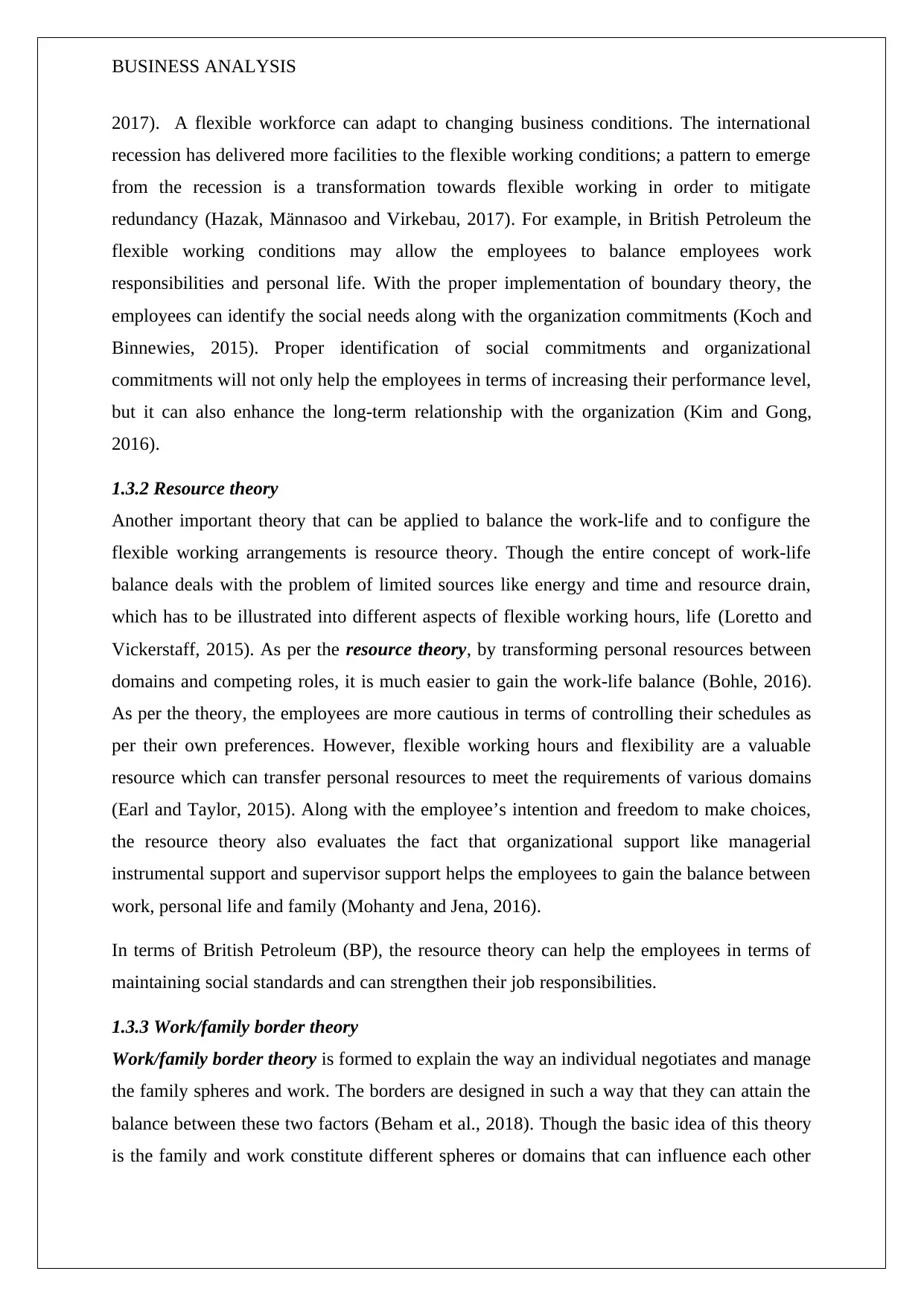
BUSINESS ANALYSIS
2017). A flexible workforce can adapt to changing business conditions. The international
recession has delivered more facilities to the flexible working conditions; a pattern to emerge
from the recession is a transformation towards flexible working in order to mitigate
redundancy (Hazak, Männasoo and Virkebau, 2017). For example, in British Petroleum the
flexible working conditions may allow the employees to balance employees work
responsibilities and personal life. With the proper implementation of boundary theory, the
employees can identify the social needs along with the organization commitments (Koch and
Binnewies, 2015). Proper identification of social commitments and organizational
commitments will not only help the employees in terms of increasing their performance level,
but it can also enhance the long-term relationship with the organization (Kim and Gong,
2016).
1.3.2 Resource theory
Another important theory that can be applied to balance the work-life and to configure the
flexible working arrangements is resource theory. Though the entire concept of work-life
balance deals with the problem of limited sources like energy and time and resource drain,
which has to be illustrated into different aspects of flexible working hours, life (Loretto and
Vickerstaff, 2015). As per the resource theory, by transforming personal resources between
domains and competing roles, it is much easier to gain the work-life balance (Bohle, 2016).
As per the theory, the employees are more cautious in terms of controlling their schedules as
per their own preferences. However, flexible working hours and flexibility are a valuable
resource which can transfer personal resources to meet the requirements of various domains
(Earl and Taylor, 2015). Along with the employee’s intention and freedom to make choices,
the resource theory also evaluates the fact that organizational support like managerial
instrumental support and supervisor support helps the employees to gain the balance between
work, personal life and family (Mohanty and Jena, 2016).
In terms of British Petroleum (BP), the resource theory can help the employees in terms of
maintaining social standards and can strengthen their job responsibilities.
1.3.3 Work/family border theory
Work/family border theory is formed to explain the way an individual negotiates and manage
the family spheres and work. The borders are designed in such a way that they can attain the
balance between these two factors (Beham et al., 2018). Though the basic idea of this theory
is the family and work constitute different spheres or domains that can influence each other
2017). A flexible workforce can adapt to changing business conditions. The international
recession has delivered more facilities to the flexible working conditions; a pattern to emerge
from the recession is a transformation towards flexible working in order to mitigate
redundancy (Hazak, Männasoo and Virkebau, 2017). For example, in British Petroleum the
flexible working conditions may allow the employees to balance employees work
responsibilities and personal life. With the proper implementation of boundary theory, the
employees can identify the social needs along with the organization commitments (Koch and
Binnewies, 2015). Proper identification of social commitments and organizational
commitments will not only help the employees in terms of increasing their performance level,
but it can also enhance the long-term relationship with the organization (Kim and Gong,
2016).
1.3.2 Resource theory
Another important theory that can be applied to balance the work-life and to configure the
flexible working arrangements is resource theory. Though the entire concept of work-life
balance deals with the problem of limited sources like energy and time and resource drain,
which has to be illustrated into different aspects of flexible working hours, life (Loretto and
Vickerstaff, 2015). As per the resource theory, by transforming personal resources between
domains and competing roles, it is much easier to gain the work-life balance (Bohle, 2016).
As per the theory, the employees are more cautious in terms of controlling their schedules as
per their own preferences. However, flexible working hours and flexibility are a valuable
resource which can transfer personal resources to meet the requirements of various domains
(Earl and Taylor, 2015). Along with the employee’s intention and freedom to make choices,
the resource theory also evaluates the fact that organizational support like managerial
instrumental support and supervisor support helps the employees to gain the balance between
work, personal life and family (Mohanty and Jena, 2016).
In terms of British Petroleum (BP), the resource theory can help the employees in terms of
maintaining social standards and can strengthen their job responsibilities.
1.3.3 Work/family border theory
Work/family border theory is formed to explain the way an individual negotiates and manage
the family spheres and work. The borders are designed in such a way that they can attain the
balance between these two factors (Beham et al., 2018). Though the basic idea of this theory
is the family and work constitute different spheres or domains that can influence each other
⊘ This is a preview!⊘
Do you want full access?
Subscribe today to unlock all pages.

Trusted by 1+ million students worldwide
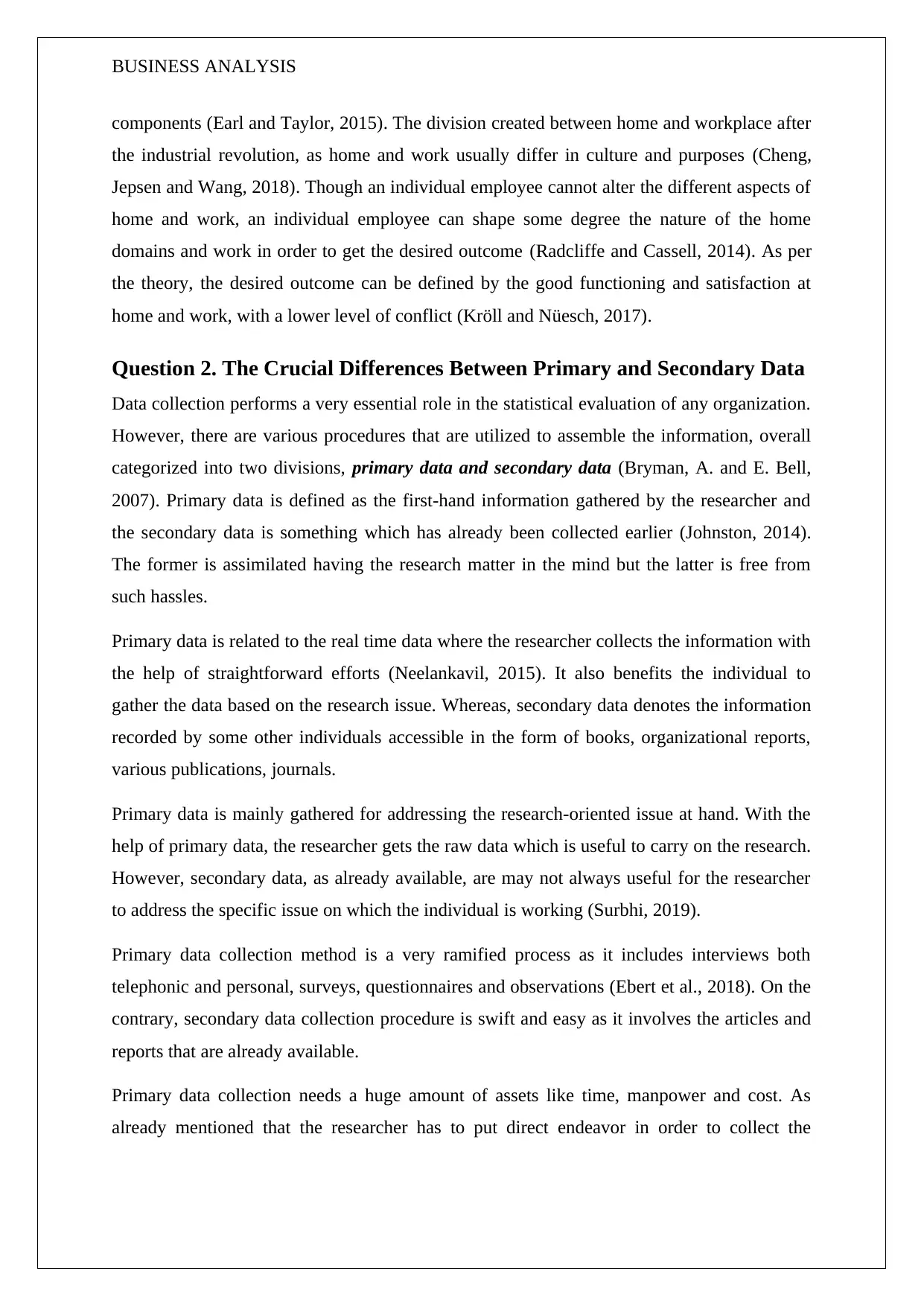
BUSINESS ANALYSIS
components (Earl and Taylor, 2015). The division created between home and workplace after
the industrial revolution, as home and work usually differ in culture and purposes (Cheng,
Jepsen and Wang, 2018). Though an individual employee cannot alter the different aspects of
home and work, an individual employee can shape some degree the nature of the home
domains and work in order to get the desired outcome (Radcliffe and Cassell, 2014). As per
the theory, the desired outcome can be defined by the good functioning and satisfaction at
home and work, with a lower level of conflict (Kröll and Nüesch, 2017).
Question 2. The Crucial Differences Between Primary and Secondary Data
Data collection performs a very essential role in the statistical evaluation of any organization.
However, there are various procedures that are utilized to assemble the information, overall
categorized into two divisions, primary data and secondary data (Bryman, A. and E. Bell,
2007). Primary data is defined as the first-hand information gathered by the researcher and
the secondary data is something which has already been collected earlier (Johnston, 2014).
The former is assimilated having the research matter in the mind but the latter is free from
such hassles.
Primary data is related to the real time data where the researcher collects the information with
the help of straightforward efforts (Neelankavil, 2015). It also benefits the individual to
gather the data based on the research issue. Whereas, secondary data denotes the information
recorded by some other individuals accessible in the form of books, organizational reports,
various publications, journals.
Primary data is mainly gathered for addressing the research-oriented issue at hand. With the
help of primary data, the researcher gets the raw data which is useful to carry on the research.
However, secondary data, as already available, are may not always useful for the researcher
to address the specific issue on which the individual is working (Surbhi, 2019).
Primary data collection method is a very ramified process as it includes interviews both
telephonic and personal, surveys, questionnaires and observations (Ebert et al., 2018). On the
contrary, secondary data collection procedure is swift and easy as it involves the articles and
reports that are already available.
Primary data collection needs a huge amount of assets like time, manpower and cost. As
already mentioned that the researcher has to put direct endeavor in order to collect the
components (Earl and Taylor, 2015). The division created between home and workplace after
the industrial revolution, as home and work usually differ in culture and purposes (Cheng,
Jepsen and Wang, 2018). Though an individual employee cannot alter the different aspects of
home and work, an individual employee can shape some degree the nature of the home
domains and work in order to get the desired outcome (Radcliffe and Cassell, 2014). As per
the theory, the desired outcome can be defined by the good functioning and satisfaction at
home and work, with a lower level of conflict (Kröll and Nüesch, 2017).
Question 2. The Crucial Differences Between Primary and Secondary Data
Data collection performs a very essential role in the statistical evaluation of any organization.
However, there are various procedures that are utilized to assemble the information, overall
categorized into two divisions, primary data and secondary data (Bryman, A. and E. Bell,
2007). Primary data is defined as the first-hand information gathered by the researcher and
the secondary data is something which has already been collected earlier (Johnston, 2014).
The former is assimilated having the research matter in the mind but the latter is free from
such hassles.
Primary data is related to the real time data where the researcher collects the information with
the help of straightforward efforts (Neelankavil, 2015). It also benefits the individual to
gather the data based on the research issue. Whereas, secondary data denotes the information
recorded by some other individuals accessible in the form of books, organizational reports,
various publications, journals.
Primary data is mainly gathered for addressing the research-oriented issue at hand. With the
help of primary data, the researcher gets the raw data which is useful to carry on the research.
However, secondary data, as already available, are may not always useful for the researcher
to address the specific issue on which the individual is working (Surbhi, 2019).
Primary data collection method is a very ramified process as it includes interviews both
telephonic and personal, surveys, questionnaires and observations (Ebert et al., 2018). On the
contrary, secondary data collection procedure is swift and easy as it involves the articles and
reports that are already available.
Primary data collection needs a huge amount of assets like time, manpower and cost. As
already mentioned that the researcher has to put direct endeavor in order to collect the
Paraphrase This Document
Need a fresh take? Get an instant paraphrase of this document with our AI Paraphraser
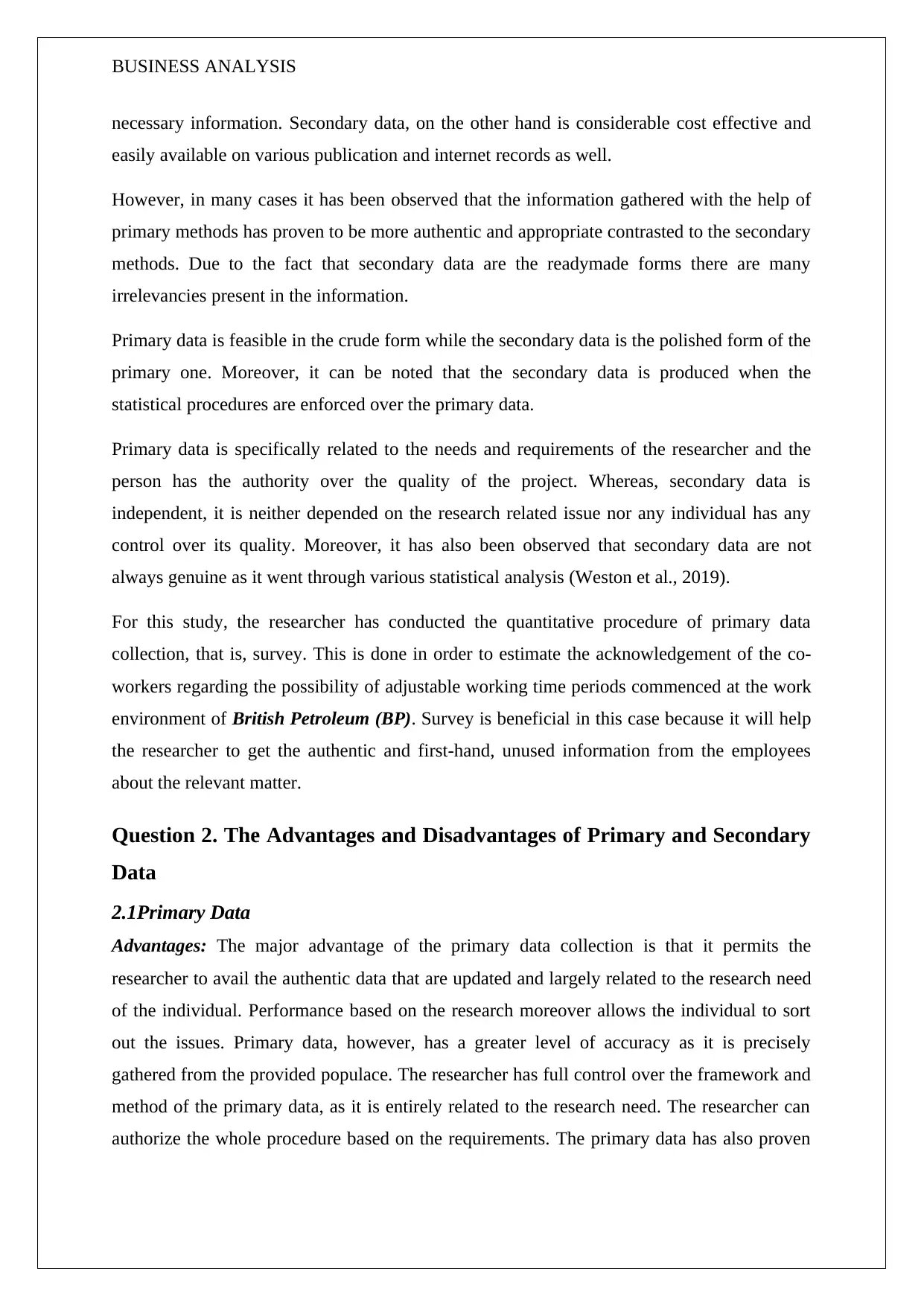
BUSINESS ANALYSIS
necessary information. Secondary data, on the other hand is considerable cost effective and
easily available on various publication and internet records as well.
However, in many cases it has been observed that the information gathered with the help of
primary methods has proven to be more authentic and appropriate contrasted to the secondary
methods. Due to the fact that secondary data are the readymade forms there are many
irrelevancies present in the information.
Primary data is feasible in the crude form while the secondary data is the polished form of the
primary one. Moreover, it can be noted that the secondary data is produced when the
statistical procedures are enforced over the primary data.
Primary data is specifically related to the needs and requirements of the researcher and the
person has the authority over the quality of the project. Whereas, secondary data is
independent, it is neither depended on the research related issue nor any individual has any
control over its quality. Moreover, it has also been observed that secondary data are not
always genuine as it went through various statistical analysis (Weston et al., 2019).
For this study, the researcher has conducted the quantitative procedure of primary data
collection, that is, survey. This is done in order to estimate the acknowledgement of the co-
workers regarding the possibility of adjustable working time periods commenced at the work
environment of British Petroleum (BP). Survey is beneficial in this case because it will help
the researcher to get the authentic and first-hand, unused information from the employees
about the relevant matter.
Question 2. The Advantages and Disadvantages of Primary and Secondary
Data
2.1Primary Data
Advantages: The major advantage of the primary data collection is that it permits the
researcher to avail the authentic data that are updated and largely related to the research need
of the individual. Performance based on the research moreover allows the individual to sort
out the issues. Primary data, however, has a greater level of accuracy as it is precisely
gathered from the provided populace. The researcher has full control over the framework and
method of the primary data, as it is entirely related to the research need. The researcher can
authorize the whole procedure based on the requirements. The primary data has also proven
necessary information. Secondary data, on the other hand is considerable cost effective and
easily available on various publication and internet records as well.
However, in many cases it has been observed that the information gathered with the help of
primary methods has proven to be more authentic and appropriate contrasted to the secondary
methods. Due to the fact that secondary data are the readymade forms there are many
irrelevancies present in the information.
Primary data is feasible in the crude form while the secondary data is the polished form of the
primary one. Moreover, it can be noted that the secondary data is produced when the
statistical procedures are enforced over the primary data.
Primary data is specifically related to the needs and requirements of the researcher and the
person has the authority over the quality of the project. Whereas, secondary data is
independent, it is neither depended on the research related issue nor any individual has any
control over its quality. Moreover, it has also been observed that secondary data are not
always genuine as it went through various statistical analysis (Weston et al., 2019).
For this study, the researcher has conducted the quantitative procedure of primary data
collection, that is, survey. This is done in order to estimate the acknowledgement of the co-
workers regarding the possibility of adjustable working time periods commenced at the work
environment of British Petroleum (BP). Survey is beneficial in this case because it will help
the researcher to get the authentic and first-hand, unused information from the employees
about the relevant matter.
Question 2. The Advantages and Disadvantages of Primary and Secondary
Data
2.1Primary Data
Advantages: The major advantage of the primary data collection is that it permits the
researcher to avail the authentic data that are updated and largely related to the research need
of the individual. Performance based on the research moreover allows the individual to sort
out the issues. Primary data, however, has a greater level of accuracy as it is precisely
gathered from the provided populace. The researcher has full control over the framework and
method of the primary data, as it is entirely related to the research need. The researcher can
authorize the whole procedure based on the requirements. The primary data has also proven
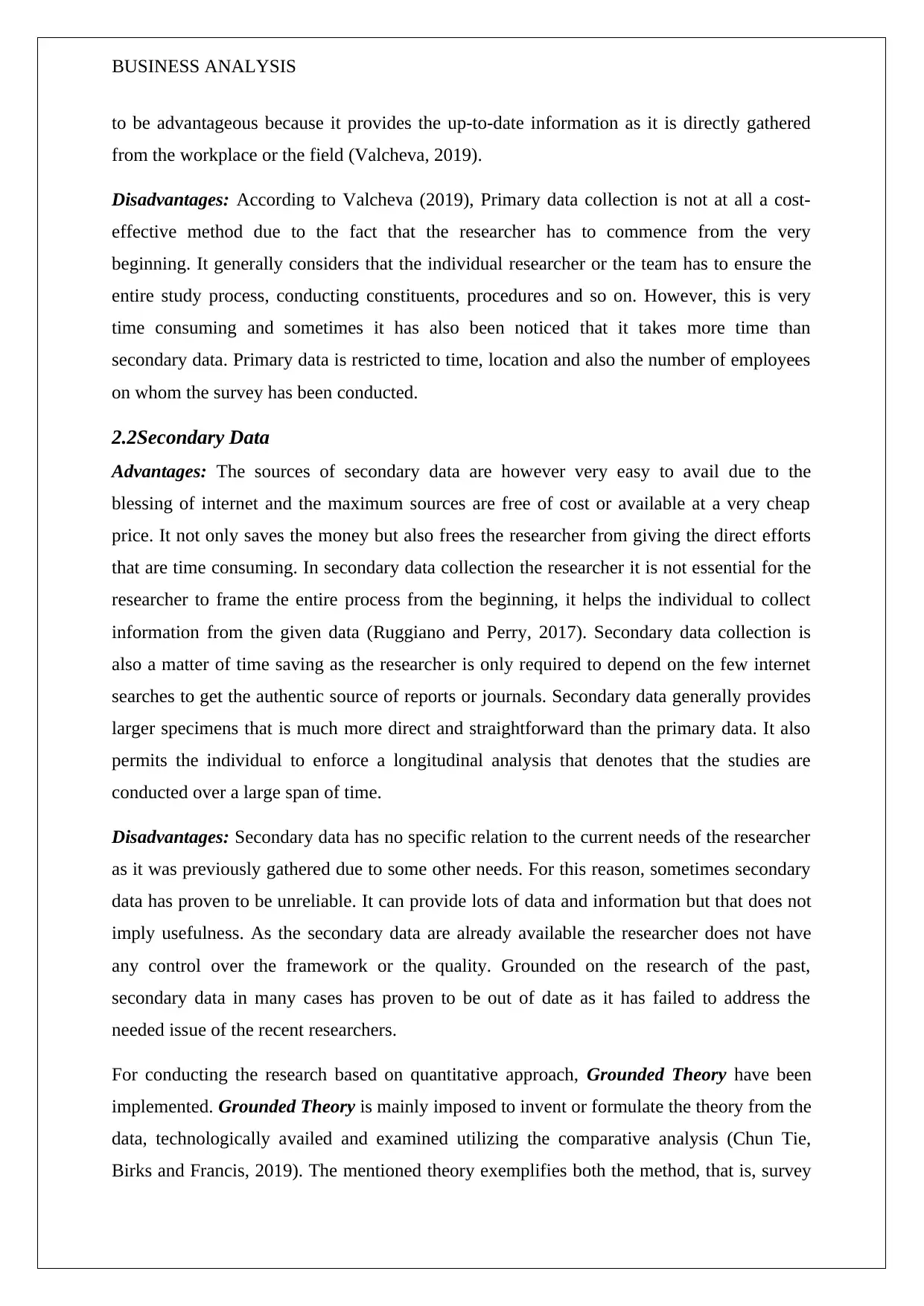
BUSINESS ANALYSIS
to be advantageous because it provides the up-to-date information as it is directly gathered
from the workplace or the field (Valcheva, 2019).
Disadvantages: According to Valcheva (2019), Primary data collection is not at all a cost-
effective method due to the fact that the researcher has to commence from the very
beginning. It generally considers that the individual researcher or the team has to ensure the
entire study process, conducting constituents, procedures and so on. However, this is very
time consuming and sometimes it has also been noticed that it takes more time than
secondary data. Primary data is restricted to time, location and also the number of employees
on whom the survey has been conducted.
2.2Secondary Data
Advantages: The sources of secondary data are however very easy to avail due to the
blessing of internet and the maximum sources are free of cost or available at a very cheap
price. It not only saves the money but also frees the researcher from giving the direct efforts
that are time consuming. In secondary data collection the researcher it is not essential for the
researcher to frame the entire process from the beginning, it helps the individual to collect
information from the given data (Ruggiano and Perry, 2017). Secondary data collection is
also a matter of time saving as the researcher is only required to depend on the few internet
searches to get the authentic source of reports or journals. Secondary data generally provides
larger specimens that is much more direct and straightforward than the primary data. It also
permits the individual to enforce a longitudinal analysis that denotes that the studies are
conducted over a large span of time.
Disadvantages: Secondary data has no specific relation to the current needs of the researcher
as it was previously gathered due to some other needs. For this reason, sometimes secondary
data has proven to be unreliable. It can provide lots of data and information but that does not
imply usefulness. As the secondary data are already available the researcher does not have
any control over the framework or the quality. Grounded on the research of the past,
secondary data in many cases has proven to be out of date as it has failed to address the
needed issue of the recent researchers.
For conducting the research based on quantitative approach, Grounded Theory have been
implemented. Grounded Theory is mainly imposed to invent or formulate the theory from the
data, technologically availed and examined utilizing the comparative analysis (Chun Tie,
Birks and Francis, 2019). The mentioned theory exemplifies both the method, that is, survey
to be advantageous because it provides the up-to-date information as it is directly gathered
from the workplace or the field (Valcheva, 2019).
Disadvantages: According to Valcheva (2019), Primary data collection is not at all a cost-
effective method due to the fact that the researcher has to commence from the very
beginning. It generally considers that the individual researcher or the team has to ensure the
entire study process, conducting constituents, procedures and so on. However, this is very
time consuming and sometimes it has also been noticed that it takes more time than
secondary data. Primary data is restricted to time, location and also the number of employees
on whom the survey has been conducted.
2.2Secondary Data
Advantages: The sources of secondary data are however very easy to avail due to the
blessing of internet and the maximum sources are free of cost or available at a very cheap
price. It not only saves the money but also frees the researcher from giving the direct efforts
that are time consuming. In secondary data collection the researcher it is not essential for the
researcher to frame the entire process from the beginning, it helps the individual to collect
information from the given data (Ruggiano and Perry, 2017). Secondary data collection is
also a matter of time saving as the researcher is only required to depend on the few internet
searches to get the authentic source of reports or journals. Secondary data generally provides
larger specimens that is much more direct and straightforward than the primary data. It also
permits the individual to enforce a longitudinal analysis that denotes that the studies are
conducted over a large span of time.
Disadvantages: Secondary data has no specific relation to the current needs of the researcher
as it was previously gathered due to some other needs. For this reason, sometimes secondary
data has proven to be unreliable. It can provide lots of data and information but that does not
imply usefulness. As the secondary data are already available the researcher does not have
any control over the framework or the quality. Grounded on the research of the past,
secondary data in many cases has proven to be out of date as it has failed to address the
needed issue of the recent researchers.
For conducting the research based on quantitative approach, Grounded Theory have been
implemented. Grounded Theory is mainly imposed to invent or formulate the theory from the
data, technologically availed and examined utilizing the comparative analysis (Chun Tie,
Birks and Francis, 2019). The mentioned theory exemplifies both the method, that is, survey
⊘ This is a preview!⊘
Do you want full access?
Subscribe today to unlock all pages.

Trusted by 1+ million students worldwide
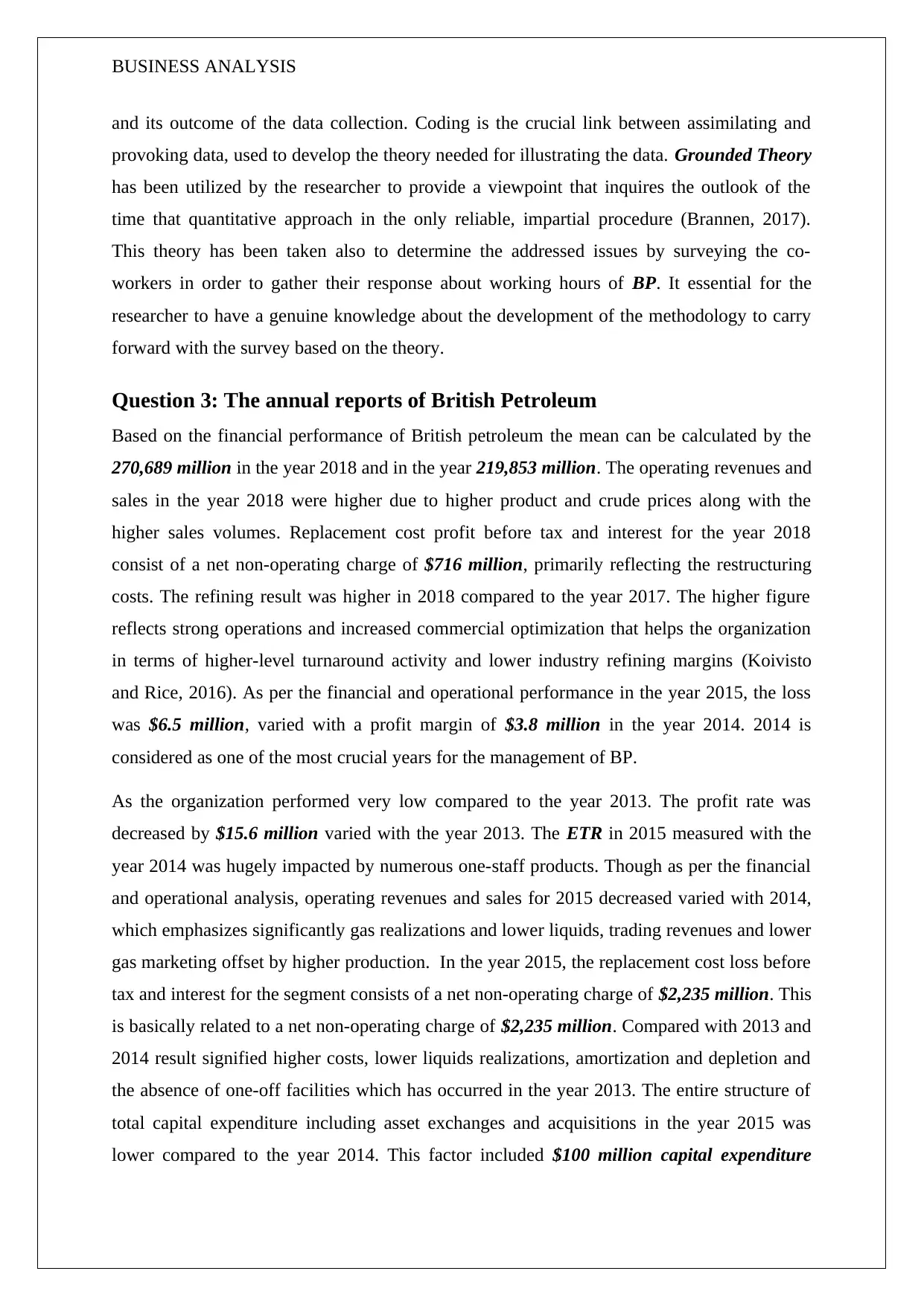
BUSINESS ANALYSIS
and its outcome of the data collection. Coding is the crucial link between assimilating and
provoking data, used to develop the theory needed for illustrating the data. Grounded Theory
has been utilized by the researcher to provide a viewpoint that inquires the outlook of the
time that quantitative approach in the only reliable, impartial procedure (Brannen, 2017).
This theory has been taken also to determine the addressed issues by surveying the co-
workers in order to gather their response about working hours of BP. It essential for the
researcher to have a genuine knowledge about the development of the methodology to carry
forward with the survey based on the theory.
Question 3: The annual reports of British Petroleum
Based on the financial performance of British petroleum the mean can be calculated by the
270,689 million in the year 2018 and in the year 219,853 million. The operating revenues and
sales in the year 2018 were higher due to higher product and crude prices along with the
higher sales volumes. Replacement cost profit before tax and interest for the year 2018
consist of a net non-operating charge of $716 million, primarily reflecting the restructuring
costs. The refining result was higher in 2018 compared to the year 2017. The higher figure
reflects strong operations and increased commercial optimization that helps the organization
in terms of higher-level turnaround activity and lower industry refining margins (Koivisto
and Rice, 2016). As per the financial and operational performance in the year 2015, the loss
was $6.5 million, varied with a profit margin of $3.8 million in the year 2014. 2014 is
considered as one of the most crucial years for the management of BP.
As the organization performed very low compared to the year 2013. The profit rate was
decreased by $15.6 million varied with the year 2013. The ETR in 2015 measured with the
year 2014 was hugely impacted by numerous one-staff products. Though as per the financial
and operational analysis, operating revenues and sales for 2015 decreased varied with 2014,
which emphasizes significantly gas realizations and lower liquids, trading revenues and lower
gas marketing offset by higher production. In the year 2015, the replacement cost loss before
tax and interest for the segment consists of a net non-operating charge of $2,235 million. This
is basically related to a net non-operating charge of $2,235 million. Compared with 2013 and
2014 result signified higher costs, lower liquids realizations, amortization and depletion and
the absence of one-off facilities which has occurred in the year 2013. The entire structure of
total capital expenditure including asset exchanges and acquisitions in the year 2015 was
lower compared to the year 2014. This factor included $100 million capital expenditure
and its outcome of the data collection. Coding is the crucial link between assimilating and
provoking data, used to develop the theory needed for illustrating the data. Grounded Theory
has been utilized by the researcher to provide a viewpoint that inquires the outlook of the
time that quantitative approach in the only reliable, impartial procedure (Brannen, 2017).
This theory has been taken also to determine the addressed issues by surveying the co-
workers in order to gather their response about working hours of BP. It essential for the
researcher to have a genuine knowledge about the development of the methodology to carry
forward with the survey based on the theory.
Question 3: The annual reports of British Petroleum
Based on the financial performance of British petroleum the mean can be calculated by the
270,689 million in the year 2018 and in the year 219,853 million. The operating revenues and
sales in the year 2018 were higher due to higher product and crude prices along with the
higher sales volumes. Replacement cost profit before tax and interest for the year 2018
consist of a net non-operating charge of $716 million, primarily reflecting the restructuring
costs. The refining result was higher in 2018 compared to the year 2017. The higher figure
reflects strong operations and increased commercial optimization that helps the organization
in terms of higher-level turnaround activity and lower industry refining margins (Koivisto
and Rice, 2016). As per the financial and operational performance in the year 2015, the loss
was $6.5 million, varied with a profit margin of $3.8 million in the year 2014. 2014 is
considered as one of the most crucial years for the management of BP.
As the organization performed very low compared to the year 2013. The profit rate was
decreased by $15.6 million varied with the year 2013. The ETR in 2015 measured with the
year 2014 was hugely impacted by numerous one-staff products. Though as per the financial
and operational analysis, operating revenues and sales for 2015 decreased varied with 2014,
which emphasizes significantly gas realizations and lower liquids, trading revenues and lower
gas marketing offset by higher production. In the year 2015, the replacement cost loss before
tax and interest for the segment consists of a net non-operating charge of $2,235 million. This
is basically related to a net non-operating charge of $2,235 million. Compared with 2013 and
2014 result signified higher costs, lower liquids realizations, amortization and depletion and
the absence of one-off facilities which has occurred in the year 2013. The entire structure of
total capital expenditure including asset exchanges and acquisitions in the year 2015 was
lower compared to the year 2014. This factor included $100 million capital expenditure
Paraphrase This Document
Need a fresh take? Get an instant paraphrase of this document with our AI Paraphraser
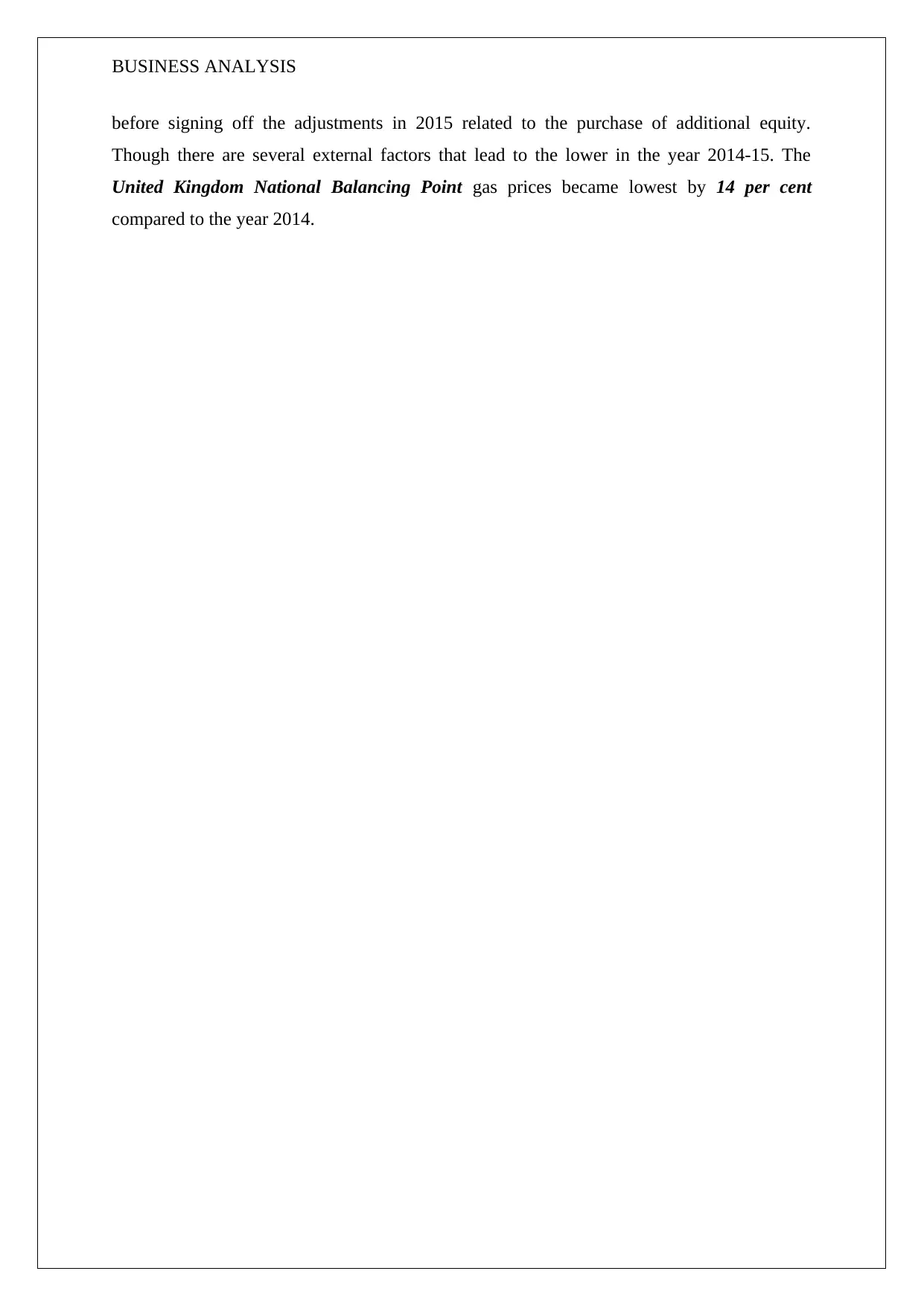
BUSINESS ANALYSIS
before signing off the adjustments in 2015 related to the purchase of additional equity.
Though there are several external factors that lead to the lower in the year 2014-15. The
United Kingdom National Balancing Point gas prices became lowest by 14 per cent
compared to the year 2014.
before signing off the adjustments in 2015 related to the purchase of additional equity.
Though there are several external factors that lead to the lower in the year 2014-15. The
United Kingdom National Balancing Point gas prices became lowest by 14 per cent
compared to the year 2014.
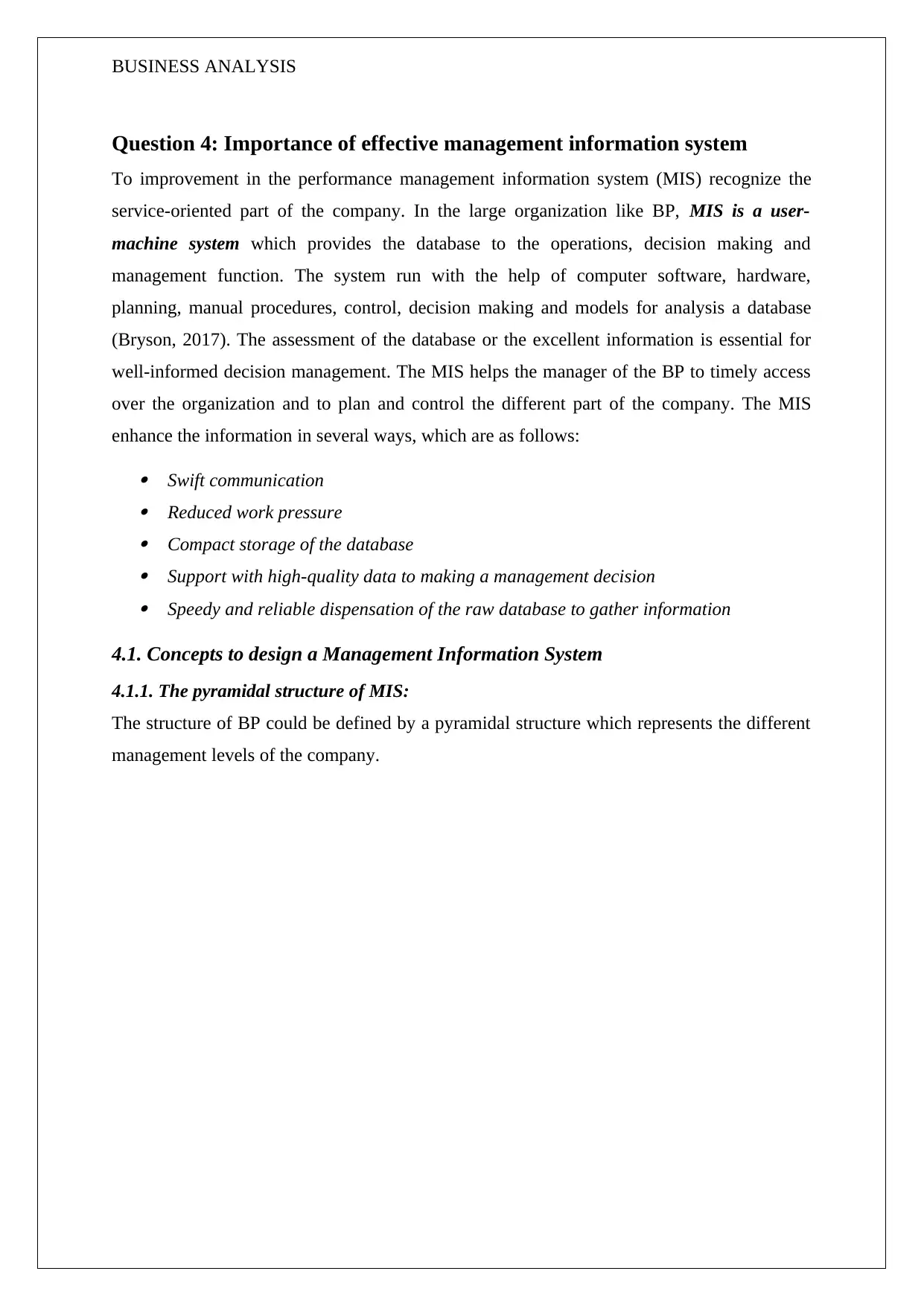
BUSINESS ANALYSIS
Question 4: Importance of effective management information system
To improvement in the performance management information system (MIS) recognize the
service-oriented part of the company. In the large organization like BP, MIS is a user-
machine system which provides the database to the operations, decision making and
management function. The system run with the help of computer software, hardware,
planning, manual procedures, control, decision making and models for analysis a database
(Bryson, 2017). The assessment of the database or the excellent information is essential for
well-informed decision management. The MIS helps the manager of the BP to timely access
over the organization and to plan and control the different part of the company. The MIS
enhance the information in several ways, which are as follows: Swift communication Reduced work pressure Compact storage of the database Support with high-quality data to making a management decision Speedy and reliable dispensation of the raw database to gather information
4.1. Concepts to design a Management Information System
4.1.1. The pyramidal structure of MIS:
The structure of BP could be defined by a pyramidal structure which represents the different
management levels of the company.
Question 4: Importance of effective management information system
To improvement in the performance management information system (MIS) recognize the
service-oriented part of the company. In the large organization like BP, MIS is a user-
machine system which provides the database to the operations, decision making and
management function. The system run with the help of computer software, hardware,
planning, manual procedures, control, decision making and models for analysis a database
(Bryson, 2017). The assessment of the database or the excellent information is essential for
well-informed decision management. The MIS helps the manager of the BP to timely access
over the organization and to plan and control the different part of the company. The MIS
enhance the information in several ways, which are as follows: Swift communication Reduced work pressure Compact storage of the database Support with high-quality data to making a management decision Speedy and reliable dispensation of the raw database to gather information
4.1. Concepts to design a Management Information System
4.1.1. The pyramidal structure of MIS:
The structure of BP could be defined by a pyramidal structure which represents the different
management levels of the company.
⊘ This is a preview!⊘
Do you want full access?
Subscribe today to unlock all pages.

Trusted by 1+ million students worldwide
1 out of 23
Related Documents
Your All-in-One AI-Powered Toolkit for Academic Success.
+13062052269
info@desklib.com
Available 24*7 on WhatsApp / Email
![[object Object]](/_next/static/media/star-bottom.7253800d.svg)
Unlock your academic potential
Copyright © 2020–2025 A2Z Services. All Rights Reserved. Developed and managed by ZUCOL.





